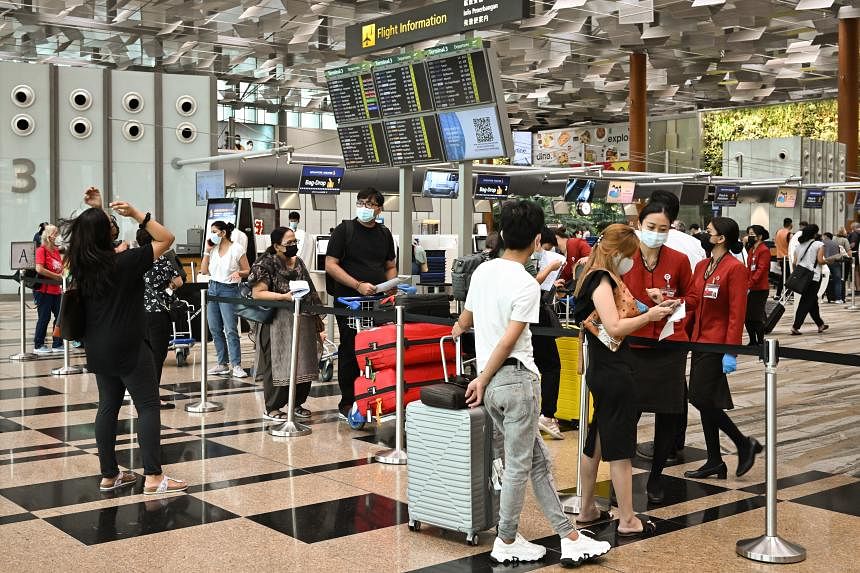SINGAPORE - Some 58.9 million passengers passed through Changi Airport in 2023, rebounding to 86 per cent of traffic levels seen before the Covid-19 pandemic.
This was also an 83 per cent increase from the 32.2 million passengers the airport handled in 2022.
In 2019, before the pandemic hit, the airport registered 68.3 million passenger movements.
About 328,000 flights took off from or landed at Changi Airport in 2023, according to the latest figures released by airport operator Changi Airport Group (CAG) on Jan 24. It handled 382,000 flights in 2019.
Between October and December 2023, the airport recorded 16.1 million passenger movements, surpassing 90 per cent of pre-pandemic levels.
December was the busiest month of the year for Changi Airport, with 5.8 million passengers moving through it. This was 91 per cent of traffic levels in December 2019.
The airport recorded its busiest day of the year on Dec 22, the Friday before Christmas, with 203,000 passengers passing through its terminals.
In December, 30,400 flights landed at or departed from Changi Airport.
CAG said all regions to which the airport is connected are recording healthy recovery in passenger traffic from pre-pandemic levels. North America was the region that recorded the greatest growth of more than 25 per cent compared with 2019.
Meanwhile, Europe, the South-west Pacific (comprising Australia, New Zealand and the Pacific Islands such as Fiji) and South Asia are near full recovery, rebounding to more than 90 per cent of passenger traffic levels in 2019.
Compared with 2022, North-east Asia was Changi Airport’s leading region in 2023, with passenger traffic increasing more than four times from that of the previous year. This was mostly due to a rise in travel between China and Singapore, said CAG.
China had gradually loosened its Covid-19 controls from January 2023. Singapore later became one of the first countries China allowed its citizens to travel to in tour groups. Last July, China reinstated 15-day visa-free entry for Singaporeans.
From early 2024, a 30-day mutual visa-free arrangement between Singapore and China is set to be rolled out.
Following closely behind North-east Asia was South-east Asia, which posted the second-strongest growth for the airport in 2023, growing 72 per cent from a year ago.
Changi Airport’s top five markets for 2023 by passenger traffic were Indonesia, Malaysia, Australia, Thailand and India.
Among the airport’s top 10 markets, China, Japan and South Korea were the fastest growing compared with 2022.
The busiest routes to and from the airport throughout the year were Kuala Lumpur in Malaysia, Bangkok in Thailand, Jakarta in Indonesia, Denpasar in Bali, Indonesia, and Manila in the Philippines.
Changi Airport’s cargo flows dipped 6 per cent compared with 2022, amid global economic uncertainty and inflationary pressures.
Mr Lim Ching Kiat, executive vice-president for air hub and cargo development at CAG, noted that the airport had resumed connections to more than 10 cities in 2023, including Addis Ababa, capital of Ethiopia, and Okinawa in Japan. It also restored almost 90 per cent of its pre-pandemic city links, making it the world’s fifth-busiest international airport by seat capacity in 2023.
Mr Lim added: “We step into 2024 hopeful of making a full recovery to Changi Airport’s pre-Covid-19 connectivity and traffic levels.”
In 2023, the airport also brought in three passenger airlines. Air Macau restored flights to Macau in March, Malaysian low-cost carrier Firefly made a comeback with flights to Penang the same month, and Indonesian budget airline TransNusa started services to Jakarta in November.
As at January 2024, 93 airlines operate more than 6,700 weekly scheduled flights at Changi Airport, which connect Singapore to 154 cities in 49 countries and territories worldwide.
Compared with January 2020 before the effects of the pandemic kicked in, more than 100 airlines ran about 7,400 weekly scheduled flights then, linking Singapore to over 170 cities in about 50 countries.
Independent analyst Brendan Sobie of Sobie Aviation noted that despite Changi Airport’s 86 per cent recovery to pre-pandemic levels, it has been hovering around the 90 per cent mark since May 2023, while other major airports in the region have been closing the gap.
In the fourth quarter of 2023, traffic at Seoul’s Incheon Airport had recovered to 92 per cent of pre-Covid-19 levels, compared with 86 per cent in the third quarter.
In comparison, Changi Airport’s traffic improved marginally from 89 per cent of pre-pandemic levels in the third quarter to 90 per cent in the fourth quarter.
With passenger demand likely to weaken and capacity not being fully restored at Changi Airport in 2024, Mr Sobie predicts a 95 per cent recovery to pre-Covid-19 levels for the year.
Mr Mayur Patel, head of Asia at global travel data provider OAG Aviation, attributed the airport’s performance in 2023 to the quick recovery across all markets, especially with the recent restoration of capacity to China.
He noted that as at January, Changi Airport is the fourth-busiest international airport, behind Incheon in third place, while Hong Kong International Airport is seventh.
Mr Patel predicts Hong Kong will surpass Changi to become the busiest international hub in the Asia-Pacific, as it continues rebuilding capacity and tapping opportunities from the Greater Bay Area, which spans China’s Guangdong province, Hong Kong and Macau.
The remaining stretch of Changi Airport’s recovery will be a “slow march”, and is possible by the end of 2024 or early 2025, he said.
The obstacles include a gloomy macroeconomic outlook, an unstable geopolitical climate and government policies, he added.

